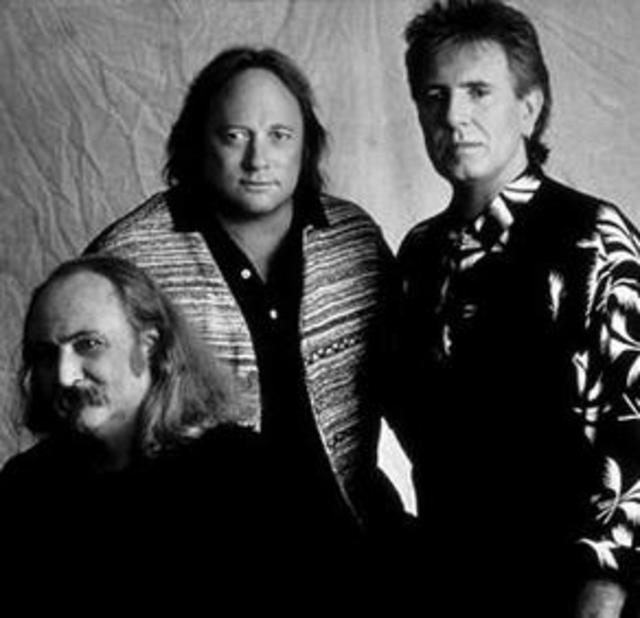Crosby, Stills and Nash

Inductees: David Crosby (vocals, guitar; born August 14, 1941), Graham Nash (vocals, guitar; born February 2, 1942), Stephen Stills (vocals, guitar, keyboards, bass; born January 3, 1945)Crosby, Stills & Nash have remained America's longest-running experiment in vocal harmony and social relevance. The trio brought harmony to the forefront of popular music with their unique three-part vocal blend. A low-key supergroup, they emphasized singing and songwriting above all, and their example contributed to the evolution of the singer/songwriter movement in the Seventies. Born out of well-known groups that placed a premium on harmony, Crosby, Stills & Nash boasted impressive individual credentials before they joined forces in 1969. David Crosby sang and played rhythm guitar with the Byrds. Stephen Stills was a mainstay of Buffalo Springfield. Nash provided the high harmonies that helped make pop sensations of Britain's Hollies. Even with those estimable prior alliances, Crosby, Stills & Nash would become their pinnacle as musicians.They met in 1968 on the sociable Los Angeles music scene, with Cass Elliot of the Mamas and the Papas making the introductions. Their unmistakable vocal blend was described in Rolling Stone's review of their first album as "warm and full, with a built-in kineticism produced by three good voices emerging asynchronously on the same phrase with rich, complementary harmonies." Particularly on their classic first album, CSN helped steer rock to a more contemplative, song-oriented place, and they made reference to what they did (owing to the frequent use of acoustic instruments) as "wooden music." In so doing, they helped pave the way for the success of kindred spirits like Joni Mitchell, James Taylor and Jackson Browne. Their debut album-simply titled Crosby, Stills & Nash-arrived early in the summer of 1969, a few months before Woodstock, which marked their second public appearance.With their glistening three-part harmonies, Still's instrumental virtuosity and the trio's inspired songwriting-which spoke the language of the counterculture both in personal and political terms-Crosby, & and Nash quickly attained the stature of a masterwork, yielding such classics as "Suite: Judy Blue Eyes" (written for and about Judy Collins), "Wooden Ships" and "Long Time Gone." It was followed a year later by Deja Vu, a more eclectic and electric endeavor in which the group expanded with the addition of Neil Young (late of Buffalo Springfield) and the rhythm section of Dallas Taylor and Greg Reeves. Shortly after its release, CSNY recorded "Ohio," a song written by Young in response to the killing of four students at Kent State University by National Guardsmen during an antiwar protest. Of the political content that marked many of their songs, Nash has said: "In speaking for ourselves, [listeners] recognized that we were speaking for them, too."Performing acoustic and electric sets highlighted by guitar duels between Stills and Young and the foursome's affecting harmonies, Crosby, Stills, Nash and Young became a major concert attraction. Their malleable live show was documented on 4 Way Street, a double album. However, their internal chemistry proved too volatile to last, and CSNY disbanded in 1971. The quartet regrouped in 1974 to undertake rock's first stadium tour. CSN, a 1977 album by the trio, yielded a Top Ten hit in Nash's "Just a Song Before I Go." Daylight Again (1982) produced another Nash-penned hit, "Wasted On the Way." Its subject was the band's combative chemistry. "We have wasted an enormous amount of time on petty issues that should never have kept us from making music," Nash opined in the liner notes from the box set CSN. And yet the group has been guided by a higher sense of mission that's ultimately superseded all the squabbling. From the beginning they've been politically astute folk troubadours whose songs often address real events. "When we realized that the TV news was lying to us when we were children, we decided that we had to go tell everybody what was really going on," explained Stills. "What we've tried to do is what Thomas Paine did, just issuing broadsides."Each member has pursued a solo career, and Crosby and Nash teamed up as a duo for much of the Seventies, but Crosby, Stills & Nash has increasingly become artistic home base for the three of them-and also, from time to time, for Young. CSNY made its second studio album, American Dream, in 1988, and reunited again in the late Nineties to cut Looking Forward. Upon its release in 1999, some 30 years after Crosby, Stills & Nash, Graham Nash could forthrightly say, "We still have it. We still mean it. It's not for the money. It never was. It's for the music.""They used to say we were speaking for our generation, and I think that it's still true," Crosby noted. "You hear a lot of music these days about rage and frustration and anger, but not much about hope and love and forward motion. That's what we want to continue to stand up for."Or, as Stills once succinctly put it, "Changes, that's what our stuff is about: emotional, intellectual, musical."